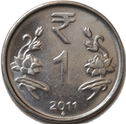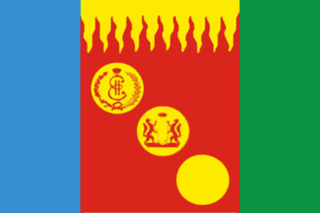| |||||
| Decades: | |||||
|---|---|---|---|---|---|
| See also: | |||||
Events in the year 1847 in Colombia.
| |||||
| Decades: | |||||
|---|---|---|---|---|---|
| See also: | |||||
Events in the year 1847 in Colombia.

Currency substitution is the use of a foreign currency in parallel to or instead of a domestic currency.

The Korean Won or Korean Empire won, was the official currency of the Korean Empire between 1900 and 1910. It was subdivided into 100 jeon.

The Bohemian and Moravian koruna, known as the Protectorate crown, was the currency of the Protectorate of Bohemia and Moravia between 1939 and 1945. It was subdivided into 100 haléřů.
The pound was the currency of the Australian Territory of New Guinea between 1915 and 1966, and replaced the New Guinean mark when Australia occupied the former German colony at the end of World War I. The New Guinean pound was subdivided into 20 shillings, each of 12 pence, and was equal to the Australian pound.

The Swiss franc has been the currency of Liechtenstein since 1920. The Swiss franc is legal tender since Liechtenstein is in a customs and monetary union with Switzerland. The 1980 treaty between Switzerland and Liechtenstein allows Liechtenstein to mint limited amounts of Swiss francs with a Liechtenstein inscription, but only in the form of commemorative coins, and they are not allowed to issue banknotes.

The 25-cent piece was the highest-denomination coin minted in the Netherlands during World War II. Struck between 1941 and 1943, the 25-cent coin was worth 1⁄4, or 0.25, of a Dutch guilder. It was made entirely of zinc, and designed by Nico de Haas, a Dutch national-socialist. The respective mintage was of 34,600,000 (1941), (1942), 13,600,000 (1943).

The zinc 10-cent coin was minted in the Netherlands between 1941 and 1943 during World War II. It was worth 1/10, or .10, of the guilder, and designed by Nico de Haas, a Dutch national-socialist. The respective mintage was of 29,800,000 (1941), 95,600,000 (1942), 29,000,000 (1943).
The One guilder coin was a coin struck in the Kingdom of the Netherlands between 1818 and 2001. It remained in circulation until 2002 when the guilder currency was replaced by the euro. No guilder coins were minted in the German occupation of the Netherlands in World War II.

The zinc 5-cent coin was minted in the Netherlands between 1941 and 1943 during World War II. It was worth 1/20, or .05, of the guilder, and designed by Nico de Haas, a Dutch national-socialist.

The 2+1⁄2-cent coin minted in the Netherlands during World War II was made of zinc, and worth 1⁄40, or .025, of the Dutch guilder. It was designed by Nico de Haas, a Dutch national-socialist, and struck in 1941 and 1942.
During World War II, the Belgian government needed to mint coins using metal that would not be needed for the war effort. Therefore, silver coinage was discontinued and coins were instead minted using pure zinc.
The Indian paisa is a 1⁄100 (one-hundredth) subdivision of the Indian rupee. The paisa was first introduced on 1 April 1957 after decimalisation of the Indian rupee.

Greek inscriptions similar to "ΒΑΣΙΛΕΩΣ ΒΑΣΙΛΕΩΝ ΑΡΣΑΚΟΥ ΕΥΕΡΓΕΤΟΥ ΔΙΚΑΙΟΥ ΕΠΙΦΑΝΟΥΣ ΦΙΛΕΛΛΗΝΟΣ", meaning "[coin] of king of kings Arsaces, the benefactor (Euergetes), the just (Dikaios), the illustrious, friend of the Greeks (Philhellen)", are found on coins of the Parthian Empire, starting from the reign of Artabanus I. Some variations of this inscription exist.

The Indian 1-rupee coin (₹1) is an Indian coin worth one Indian rupee and is made up of a hundred paisas. Currently, one rupee coin is the smallest Indian coin in circulation. Since 1992, one Indian rupee coins are minted from stainless steel. Round in shape, the one rupee coins weighs 3.76 grams, has a diameter of 21.93-millimetre (0.863 in) and thickness of 1.45-millimetre (0.057 in). In independent India, one rupee coins was first minted in 1950 and is currently in circulation.

The Lion Capital Series were a series of currency notes issued after India declared its independence from Great Britain and used until the Reserve Bank of India (RBI) introduced the Mahatma Gandhi Series in 1996 with banknotes in denominations of 10 and 500 rupees, and were designed with the image of the Lion Capital of Ashoka, the National Emblem which replaced the George VI banknote series. The first banknotes printed after India achieved its independence was a 1-rupee note.

Although the vast majority of coins are round, coins are made in a variety of other shapes, including squares, diamonds, hexagons, heptagons, octagons, decagons, and dodecagons. They have also been struck with scalloped (wavy) edges, and with holes in the middle. Coins in the shape of polygons often have rounded edges or are Reuleaux polygons.

The Philippine twenty-centavo (20¢) coin was a denomination of the Philippine peso. The one-fifth (1/5) peso was introduced by both the Spaniards and the Americans during the colonial era of the Philippines. It was replaced by a banknote of the same denomination introduced alongside the establishment of the Central Bank of the Philippines in 1949 and it was replaced by the twenty-five centavo coin.

Suzun is an urban locality and the administrative center of Suzunsky District of Novosibirsk Oblast, Russia. Population: 15,364 (2010 Census); 15,565 (2002 Census); 15,470 (1989 Census).

The American Veterans Disabled for Life silver dollar is a commemorative coin issued by the United States Mint in 2010. The obverse of the coin was designed by Don Everhart and featuring the legs and boots of three veterans. The coin's reverse was designed by Joseph Menna and depicts a Forget-me-not flower wrapped in a ribbon cradling and supporting clusters of oak branches, with the forget-me-not flower representing those who fought and became disabled, while the oak branches represent strength.

The Great Qing Copper Coin, also known as the Qing Dynasty Copper Coin or Da-Qing Tongbi, officially the Tai-Ching-Ti-Kuo Copper Coin, refers to a series of copper machine-struck coins from the Qing dynasty produced from 1906 until the fall of the Qing dynasty in 1911. These coins were intended to replace the earlier cast cash coins and provincial coinages, but were welcomed to mixed receptions.